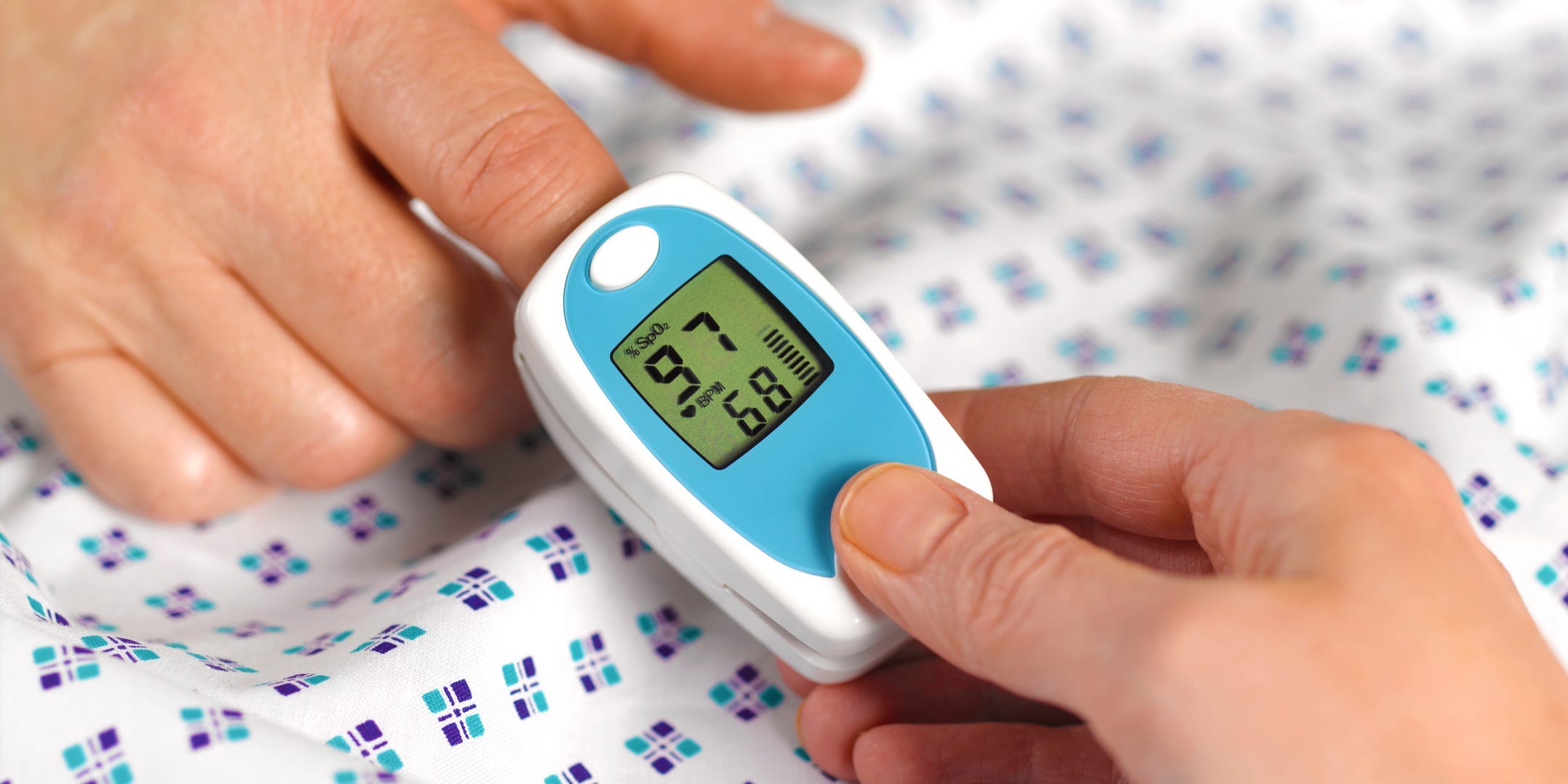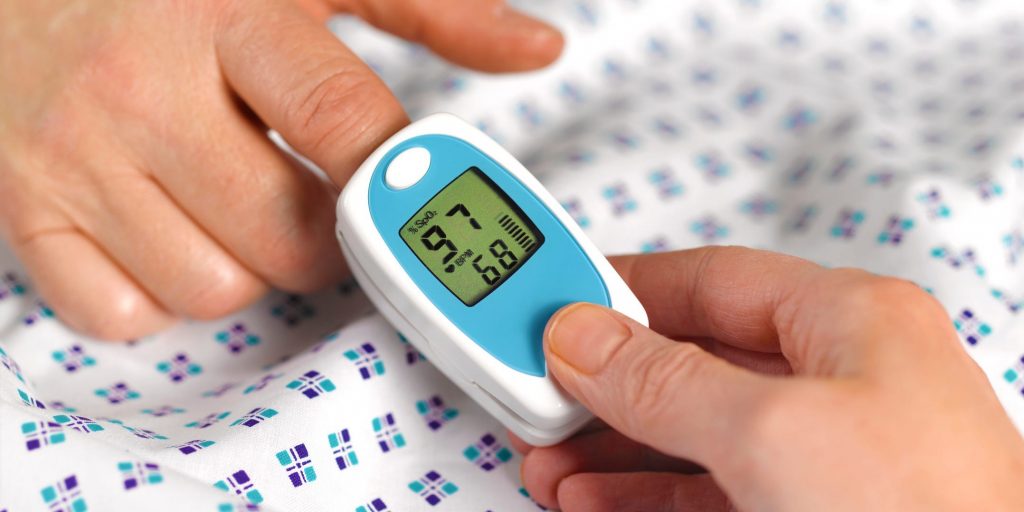
Peter Dazeley/Getty Images
- Normal blood oxygen level is either 95%-100% SpO2 on an oximeter or 80-100 mm Hg from an ABG test.
- ABG tests are more accurate than pulse oximeters, which have a margin of error of 2%-4%.
- Chronic lung conditions and infections like COVID-19 can cause dangerously low blood oxygen levels.
- Visit Insider's Health Reference library for more advice.
Normal blood oxygen levels mean that there is enough oxygen in your red blood cells to keep your vital organs and tissues functioning properly.
You can easily check your blood oxygen levels with an oximeter, which provides readings in units of SpO2, a measure of oxygen saturation.
A normal blood oxygen level for a healthy adult or child is typically around 95% to 100% SpO2, says Lauren Ferrante, MD, a pulmonologist at Yale Medicine.
When SpO2 dips into the low 90s or below, it can lead to a condition called hypoxemia – meaning low blood oxygen levels – which can damage your brain and heart and, in severe cases, prove fatal.
There are certain infections and chronic health conditions that may reduce blood oxygen levels to dangerously low levels.
Causes and symptoms of low blood oxygen levels
Some of the most common causes of hypoxemia are heart and lung conditions, including heart disease, sleep apnea, asthma, bronchitis, emphysema, pneumonia, chronic obstructive pulmonary disease (aka COPD), and COVID-19.
Low blood oxygen, aka hypoxemia, can cause symptoms like:
- Shortness of breath
- Headache
- Lightheadedness
- Confusion
- Restlessness
- If left for too long your skin may turn blue, a condition called cyanosis
According to the American Thoracic Society (ATS), having a blood oxygen level below 89% SpO2 for a short period of time may not cause any harm.
However, your cells - particularly those in your heart and brain - may be strained or damaged if low blood oxygen levels persist for a long time or if your oxygen levels drop repeatedly.
In severe cases, if your brain is getting less oxygen, the cells can start dying within five minutes. These conditions could potentially lead to brain damage or death.
How to measure blood oxygen levels with a pulse oximeter
Whether you're measuring your own blood oxygen levels at home or you're at a medical practitioner's, you'll typically use something called a pulse oximeter, which is a small device that gently clips onto the end of your finger, says Ferrante.
Checking your oxygen level with a pulse oximeter is a painless, non-invasive procedure that only takes a few minutes to set up.
In fact, you can purchase a pulse oximeter to check your oxygen levels at home for as low as $25, says Ferrante. Oximeters are easily available online and in supermarkets, and don't require a prescription.
Ferrante recommends buying a pulse oximeter that also displays either waves or lines because this feature can help determine the accuracy of the reading. If the waves/lines go all the way to the top, it's a sign that the reading is accurate. However, if the waves/lines stay flat, or if each wave looks different, during the reading, it could indicate that the pulse oximeter isn't working as it should.
How to measure blood oxygen levels with a blood gas test
Another way that medical practitioners check oxygen levels is through an arterial blood gas (ABG) test, measured in units of PaO2. This test involves drawing blood from an artery, typically in your wrist. A normal ABG reading for a healthy adult should be between 80 mm Hg and 100 mm Hg.
An ABG reading can be used to diagnose both high and low blood oxygen levels. So for instance, if a patient is on a ventilator, their healthcare provider may do an ABG test to ensure that the oxygen level on the ventilator is not too high, says Ferrante.
An ABG test is also more accurate than a pulse oximeter reading - pulse oximeters can have a margin of error between 2% to 4%.
What to do if you have abnormal blood oxygen levels
If your blood oxygen levels are in the low 90% SpO2 range and your symptoms are mild, you should call your doctor and ask to be seen that day, says Ferrante.
However, if your blood oxygen levels go below 90% SpO2 and/or you have moderate to severe symptoms, such as lightheadedness or shortness of breath, she recommends going to the emergency room.
Low blood oxygen levels are treated with oxygen therapy, which involves delivering oxygen through a face mask, nose tubes, or endotracheal tube, which is inserted into your windpipe (aka trachea).
If you are opting for oxygen therapy at home, you can use:
- Oxygen tanks: These are special tanks that carry liquid or gaseous oxygen. They need to be refilled periodically, once the oxygen supply is depleted.
- Oxygen concentrator: This is a machine that derives oxygen from the air. It doesn't run out of oxygen and therefore doesn't need to be refilled.
Depending on your oxygen levels and your health status, your doctor will determine how much oxygen you require, how frequently, and for how long. Oxygen therapy aims to keep your blood oxygen levels above 90%.
- Coughing
- Difficulty breathing
- Chest pain
- Dizziness
- Blurry vision
- Nausea
- Confusion
- Seizures
Insider's takeaway
Measuring your blood oxygen level can help you determine whether your respiratory and circulatory systems are functioning as they should.
The easiest way to monitor your blood oxygen levels at home is to use a pulse oximeter.
Note that factors like nail polish, artificial nails, tattoos, henna, or even feeling cold can make a pulse oximeter's reading lower than what's actually going on in your body. So make sure you are using a finger, toe, or earlobe that is warm and doesn't have any dye on it.
If you're otherwise healthy and your oxygen levels are consistently below 90% SpO2, Ferrante recommends going to the emergency room. Otherwise, if you have a chronic condition or infection, it's important to consult a healthcare professional about what levels are safe for your individual circumstance.
